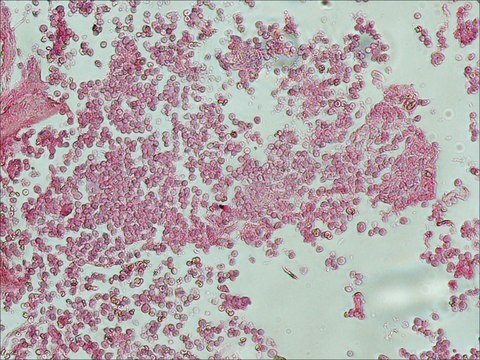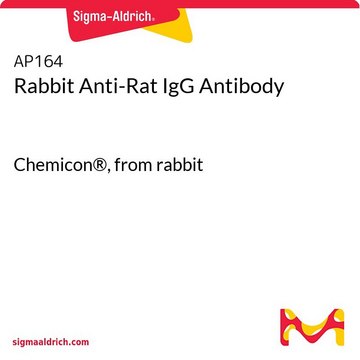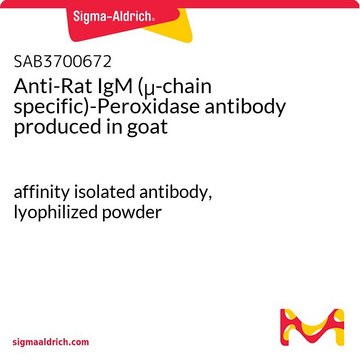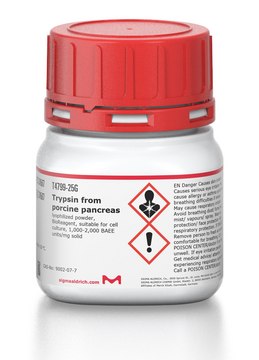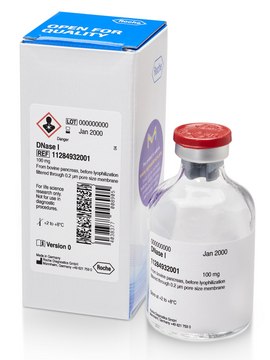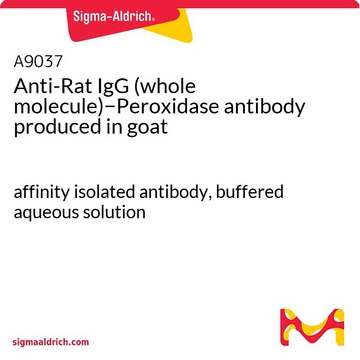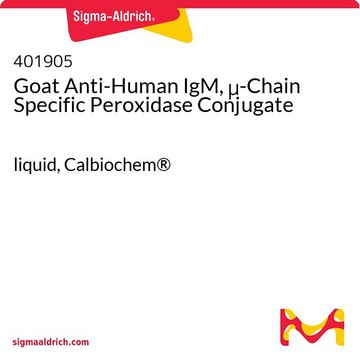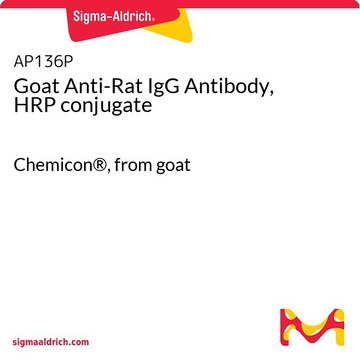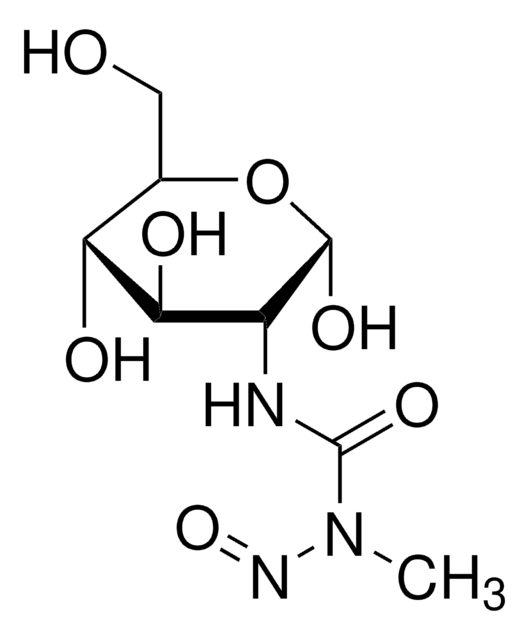R0886
Monoclonal Anti-Rat IgM antibody produced in mouse
clone RTM-32, ascites fluid
Sign Into View Organizational & Contract Pricing
All Photos(1)
About This Item
Recommended Products
biological source
mouse
Quality Level
conjugate
unconjugated
antibody form
ascites fluid
antibody product type
secondary antibodies
clone
RTM-32, monoclonal
contains
15 mM sodium azide
technique(s)
capture ELISA: suitable
dot blot: suitable
immunocytochemistry: suitable
indirect ELISA: 1:1,000
western blot: suitable
isotype
IgG1
shipped in
dry ice
storage temp.
−20°C
target post-translational modification
unmodified
General description
Monoclonal anti-Rat IgM (mouse IgG1 isotype) is derived from the RTM-32 hybridoma produced by the fusion of mouse myeloma cells and splenocytes from BALB/c mice immunized with a rat IgM myeloma preparation. Immunoglobulin M (IgM) is the first immunoglobulin to be produced, which is detected as early as 9 weeks of gestation. It has a pentameric structure, in which monomers are linked together by disulfide bonds. IgM is produced by B cells and is expressed in high concentrations in blood.
Rat immunoglobulins have seven distinct classes, namely, IgM, IgA, IgE, IgG1, IgG2a, IgG2b and IgG2c. Rat IgMs have been implicated in complement activation . Rat IgMs against target proteins are often used as primary antibodies in various research applications. Thus, secondary anti-rat IgM is a useful tool for the analysis of target proteins
Monoclonal Anti-Rat IgM antibody is specific for an epitope present on the heavy chain of rat IgM. By immunoblotting, the antibody detects the denatured-reduced heavy chain molecule of rat IgM (μ-chain). The product recognizes rat IgMs derived from normal serum or myeloma proteins, but does not detect other rat immunoglobulins. In assays such as indirect ELISA and dot blot, the antibody weakly associates with guinea pig immunoglobulins. The product does not bind to IgG or serum preparations obtained from bovine, cat, chicken, dog, goat, horse, human, mouse, pig, rabbit, or sheep.
Monoclonal Anti-Rat IgM antibody is specific for an epitope present on the heavy chain of rat IgM. By immunoblotting, the antibody detects the denatured-reduced heavy chain molecule of rat IgM (μ-chain). The product recognizes rat IgMs derived from normal serum or myeloma proteins, but does not detect other rat immunoglobulins. In assays such as indirect ELISA and dot blot, the antibody weakly associates with guinea pig immunoglobulins. The product does not bind to IgG or serum preparations obtained from bovine, cat, chicken, dog, goat, horse, human, mouse, pig, rabbit, or sheep.
Specificity
Monoclonal anti-Rat IgM recognizes an epitope located on the heavy chain of rat IgM. The antibody detects the rat IgM derived from normal serum or myeloma proteins, but not the other rat immunoglobulins.
Immunogen
Rat IgM myeloma preparation
Application
Monoclonal Anti-Rat IgM antibody is suitable for use in:
- indirect ELISA (1:1,000)
- immunocytochemistry
- immunohistochemistry
- dot blot
- immunoblotting
Biochem/physiol Actions
Immunoglobulin (IgM) serves as the first line of defense during microbial infections. It serves as the antigen receptor of naive B cells. Secreted IgM (sIgM) is implicated in B cell maturation and complement activation. Detection of IgM antibodies in a neonate′s serum may indicate intrauterine infection (e.g. congenital rubella syndrome). Development of anti-donor IgM after combined liver-kidney transplantation provides a graft-protecting effect. Anti-Human IgM (μ-specific) antibodies are used in the detection of IgM-associated pathologies, such as selective IgM immunodeficiency (SIgMID) and the hyper immunoglobulin M (hyper-IgM or HIGM) syndromes.
Physical form
The product is provided as ascites fluid with 15 mM sodium azide as a preservative.
Storage and Stability
For continuous use, store at 2-8 °C. For extended storage, freeze in working aliquots. Repeated freezing and thawing is not recommended. Storage in "frost-free" freezers is not recommended. If slight turbidity occurs upon prolonged storage, clarify the solution by centrifugation before use.
Disclaimer
Unless otherwise stated in our catalog or other company documentation accompanying the product(s), our products are intended for research use only and are not to be used for any other purpose, which includes but is not limited to, unauthorized commercial uses, in vitro diagnostic uses, ex vivo or in vivo therapeutic uses or any type of consumption or application to humans or animals.
Not finding the right product?
Try our Product Selector Tool.
Storage Class Code
10 - Combustible liquids
WGK
nwg
Flash Point(F)
Not applicable
Flash Point(C)
Not applicable
Regulatory Information
新产品
Choose from one of the most recent versions:
Already Own This Product?
Find documentation for the products that you have recently purchased in the Document Library.
Reenu K Malhotra et al.
Archives of pathology & laboratory medicine, 132(5), 847-850 (2008-05-10)
Gastroenteropancreatic neuroendocrine tumors are uncommon tumors representing 2% of all gastrointestinal tumors. We report a case of a 21-year-old man with X-linked hyperimmunoglobulin M (hyper-IgM) syndrome who presented with diarrhea and jaundice. An ultrasound and magnetic resonance imaging showed multiple
Trang T T Nguyen et al.
Critical reviews in immunology, 36(2), 163-177 (2016-12-03)
Most serum immunoglobulin M (IgM) is "natural IgM", which is produced apparently spontaneously by a distinct subset of B cells requiring no exogenous antigenic or microbial stimuli. Natural IgM is an evolutionarily conserved molecule and reacts with a variety of
Rachael Racine et al.
Immunology letters, 125(2), 79-85 (2009-06-23)
Much has been learned about the structure, function, and production of IgM, since the antibody's initial characterization. It is widely accepted that IgM provides a first line of defense during microbial infections, prior to the generation of adaptive, high-affinity IgG
Marc F Goldstein et al.
Annals of allergy, asthma & immunology : official publication of the American College of Allergy, Asthma, & Immunology, 97(6), 717-730 (2007-01-05)
To review and compare previously reported cases of selective IgM immunodeficiency (SIgMID) with the largest adult cohort obtained from a retrospective analysis of an allergy and immunology practice. Publications were selected from the English-only PubMed database (1966-2005) using the following
Chloe C McAlister et al.
Liver transplantation : official publication of the American Association for the Study of Liver Diseases and the International Liver Transplantation Society, 10(2), 315-319 (2004-02-06)
The mechanism by which a liver transplantation might protect a simultaneous kidney transplant in a crossmatch-positive recipient is unknown. Flow cytometry crossmatch (FCXM) has increased the sensitivity of donor-specific antibody (DSA) detection compared with complement-dependant cytotoxicity (CDC). Here we compare
Our team of scientists has experience in all areas of research including Life Science, Material Science, Chemical Synthesis, Chromatography, Analytical and many others.
Contact Technical Service